[Source: @Bonusctx]
Taking Portals in Movies [Comedy Sketch]
From Goat-on-a-stick:
I always thought it was weird how little thought was put into taking them.
Water in space – a ‘Goldilocks’ star reveals previously hidden step in how water gets to planets like Earth
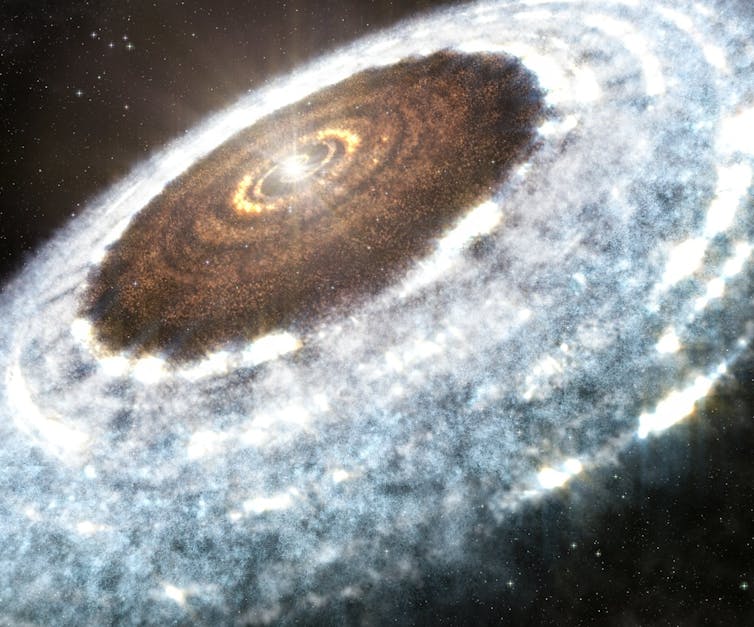
John Tobin, National Radio Astronomy Observatory
Without water, life on Earth could not exist as it does today. Understanding the history of water in the universe is critical to understanding how planets like Earth come to be.
Astronomers typically refer to the journey water takes from its formation as individual molecules in space to its resting place on the surfaces of planets as “the water trail.” The trail starts in the interstellar medium with hydrogen and oxygen gas and ends with oceans and ice caps on planets, with icy moons orbiting gas giants and icy comets and asteroids that orbit stars. The beginnings and ends of this trail are easy to see, but the middle has remained a mystery.
I am an astronomer who studies the formation of stars and planets using observations from radio and infrared telescopes. In a new paper, my colleagues and I describe the first measurements ever made of this previously hidden middle part of the water trail and what these findings mean for the water found on planets like Earth.
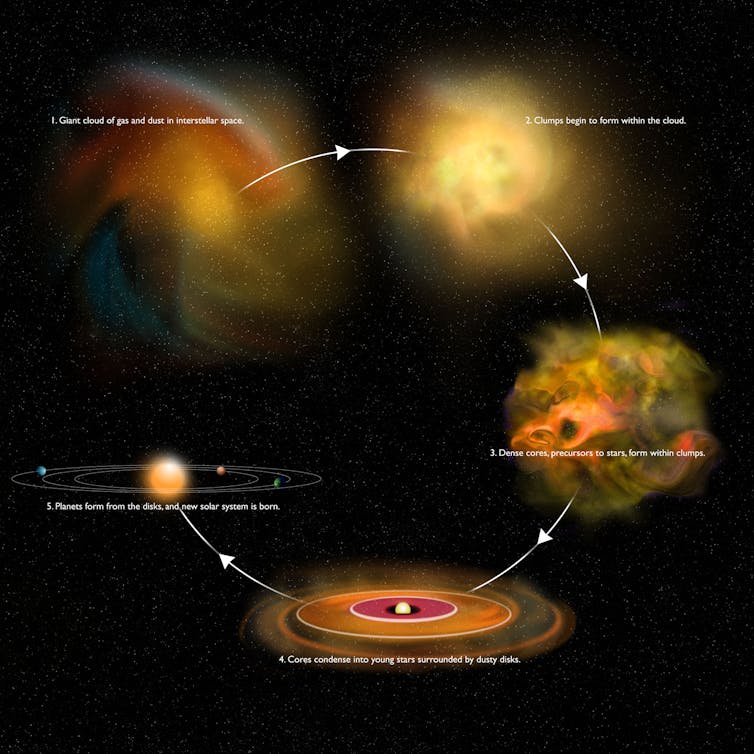
How planets are formed
The formation of stars and planets is intertwined. The so-called “emptiness of space” – or the interstellar medium – in fact contains large amounts of gaseous hydrogen, smaller amounts of other gasses and grains of dust. Due to gravity, some pockets of the interstellar medium will become more dense as particles attract each other and form clouds. As the density of these clouds increases, atoms begin to collide more frequently and form larger molecules, including water that forms on dust grains and coats the dust in ice.
Stars begin to form when parts of the collapsing cloud reach a certain density and heat up enough to start fusing hydrogen atoms together. Since only a small fraction of the gas initially collapses into the newborn protostar, the rest of the gas and dust forms a flattened disk of material circling around the spinning, newborn star. Astronomers call this a proto-planetary disk.
As icy dust particles collide with each other inside a proto-planetary disk, they begin to clump together. The process continues and eventually forms the familiar objects of space like asteroids, comets, rocky planets like Earth and gas giants like Jupiter or Saturn.
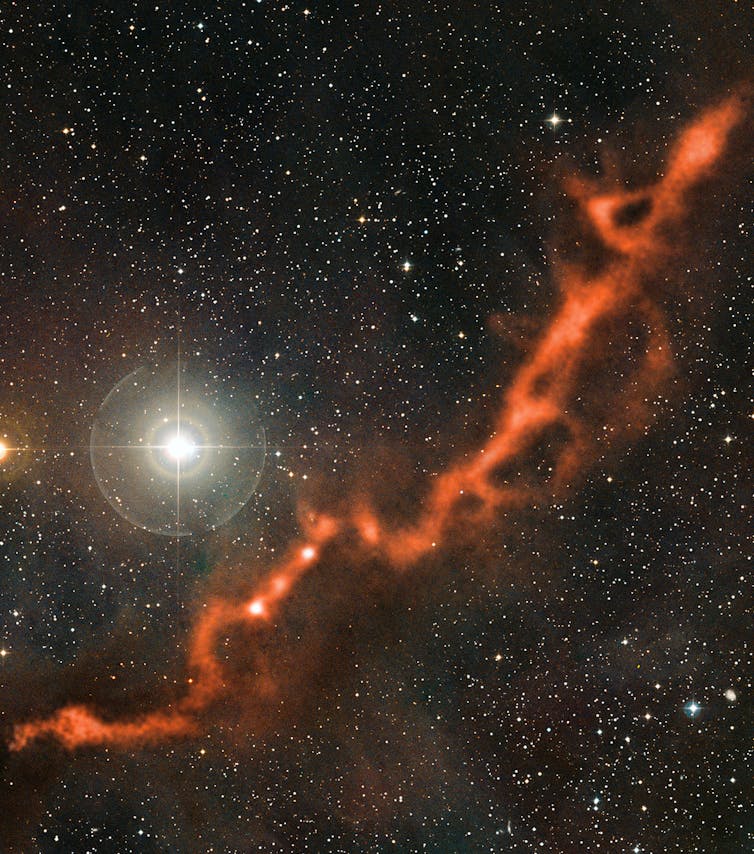
Two theories for the source of water
There are two potential pathways that water in our solar system could have taken. The first, called chemical inheritance, is when the water molecules originally formed in the interstellar medium are delivered to proto-planetary disks and all the bodies they create without going through any changes.
The second theory is called chemical reset. In this process, the heat from the formation of the proto-planetary disk and newborn star breaks apart water molecules, which then reform once the proto-planetary disk cools.
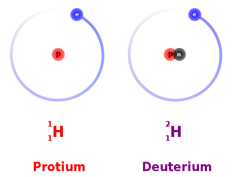
To test these theories, astronomers like me look at the ratio between normal water and a special kind of water called semi-heavy water. Water is normally made of two hydrogen atoms and one oxygen atom. Semi-heavy water is made of one oxygen atom, one hydrogen atom and one atom of deuterium – a heavier isotope of hydrogen with an extra neutron in its nucleus.
The ratio of semi-heavy to normal water is a guiding light on the water trail – measuring the ratio can tell astronomers a lot about the source of water. Chemical models and experiments have shown that about 1,000 times more semi-heavy water will be produced in the cold interstellar medium than in the conditions of a protoplanetary disk.
This difference means that by measuring the ratio of semi-heavy to normal water in a place, astronomers can tell whether that water went through the chemical inheritance or chemical reset pathway.
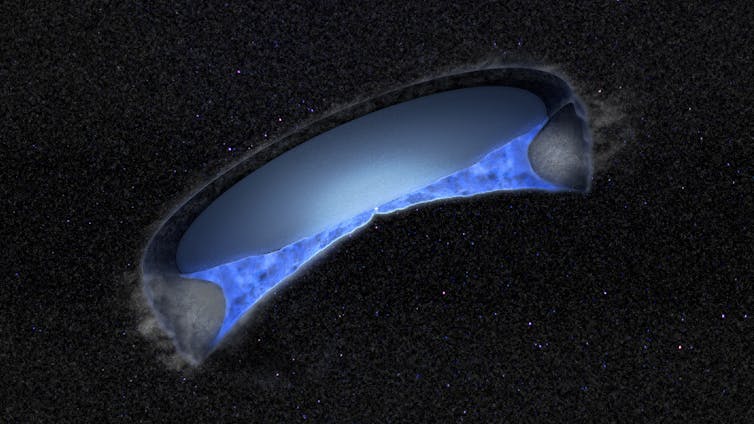
Measuring water during the formation of a planet
Comets have a ratio of semi-heavy to normal water almost perfectly in line with chemical inheritance, meaning the water hasn’t undergone a major chemical change since it was first created in space. Earth’s ratio sits somewhere in between the inheritance and reset ratio, making it unclear where the water came from.
To truly determine where the water on planets comes from, astronomers needed to find a goldilocks proto-planetary disk – one that is just the right temperature and size to allow observations of water. Doing so has proved to be incredibly difficult. It is possible to detect semi-heavy and normal water when water is a gas; unfortunately for astronomers, the vast majority of proto-plantary disks are very cold and contain mostly ice, and it is nearly impossible to measure water ratios from ice at interstellar distances.
A breakthrough came in 2016, when my colleagues and I were studying proto-planetary disks around a rare type of young star called FU Orionis stars. Most young stars consume matter from the proto-planetary disks around them. FU Orionis stars are unique because they consume matter about 100 times faster than typical young stars and, as a result, emit hundreds of times more energy. Due to this higher energy output, the proto-planetary disks around FU Orionis stars are heated to much higher temperatures, turning ice into water vapor out to large distances from the star.
Using the Atacama Large Millimeter/submillimeter Array, a powerful radio telescope in northern Chile, we discovered a large, warm proto-planetary disk around the Sunlike young star V883 Ori, about 1,300 light years from Earth in the constellation Orion.
V883 Ori emits 200 times more energy than the Sun, and my colleagues and I recognized that it was an ideal candidate to observe the semi-heavy to normal water ratio.
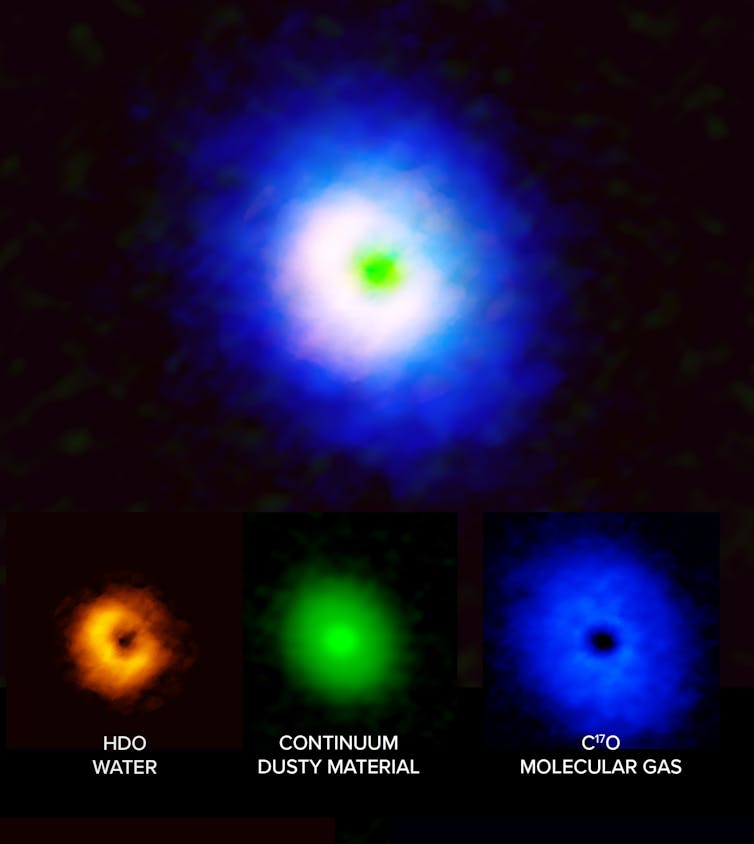
Completing the water trail
In 2021, the Atacama Large Millimeter/submillimeter Array took measurements of V883 Ori for six hours. The data revealed a strong signature of semi-heavy and normal water coming from V883 Ori’s proto-planetary disk. We measured the ratio of semi-heavy to normal water and found that the ratio was very similar to ratios found in comets as well as the ratios found in younger protostar systems.
These results fill in the gap of the water trail forging a direct link between water in the interstellar medium, protostars, proto-planetary disks and planets like Earth through the process of inheritance, not chemical reset.
The new results show definitively that a substantial portion of the water on Earth most likely formed billions of years ago, before the Sun had even ignited. Confirming this missing piece of water’s path through the universe offers clues to origins of water on Earth. Scientists have previously suggested that most water on Earth came from comets impacting the planet. The fact that Earth has less semi-heavy water than comets and V883 Ori, but more than chemical reset theory would produce, means that water on Earth likely came from more than one source.
John Tobin, Scientist, National Radio Astronomy Observatory
This article is republished from The Conversation under a Creative Commons license. Read the original article.
Today’s Hottest Deals: Bandai Hobby Star Wars 1/144 AT-AT Walker Building Kit, INSIGNIA 42-inch Smart TV, >WD_BLACK 2TB Game Drive, and More!
For today’s edition of “Deal of the Day,” here are some of the best deals we stumbled on while browsing the web this morning! Please note that Geeks are Sexy might get a small commission from qualifying purchases done through our posts (as an Amazon associate or a member of other affiliate programs.)
–Star Wars Villainous: Power of The Dark Side – Strategy Board Game – $39.99$20.81
–INSIGNIA 42-inch Class F20 Series Smart Full HD 1080p Fire TV – $269.99 $179.99
–WD_BLACK 2TB P10 Game Drive – Portable External Hard Drive – $89.99 $62.83
–Save on Phone, Tablet, and Laptop Stand Accessories (Stands, Car Mounts, etc.)
–Bandai Hobby Star Wars 1/144 AT-AT Walker Building Kit – $95.90 $66.95
–Funko Star Wars: Across The Galaxy – The Child, Grogu (Using the Force) – $12.99 $6.49
–LEGO BrickHeadz Star Wars The Mandalorian & The Child – $19.99 $15.79
–25 Rare Pokemon Cards with 100 HP or Higher (Original Version) – $19.99 $7.56
Good Boy [Comic]
[Source: @gogomachrocketsheep]
Harvard Professor Answers Questions About the Science of Happiness From the Internet
Harvard professor and “How to Build a Life” columnist Arthur C. Brooks answers the internet’s burning questions about “happiness.” Does anyone else feel depression after completing a goal? Can social media cause depression? Do we get happier as we age? What is the true meaning of happiness? Arthur answers all these questions and much more.
[Wired]
No Big Web [Comic]
[Source: @AlSkylarkcomics]
Spiky Fence [Comic]
[Source: @blanche.draws]
Can you be awake and asleep at the same time? [Science Video]
Many animals need sleep. But all of the threats and demands animals face don’t just go away when it’s time to doze. That’s why a range of birds, mammals, and even humans experience some degree of asymmetrical sleep, where parts of the brain are asleep and other areas are more active. So, how does it work? Masako Tamaki explores how animals’ brains remain vigilant even at their most vulnerable.
[TED Ed]
Today’s Hottest Deals: Apple AirPods Max, Star Wars Ice Tray / Chocolate Molds, Corsair Extended XL Gaming Mouse Pad, and MORE!
For today’s edition of “Deal of the Day,” here are some of the best deals we stumbled on while browsing the web this morning! Please note that Geeks are Sexy might get a small commission from qualifying purchases done through our posts (as an Amazon associate or a member of other affiliate programs.)
–Apple AirPods Max Wireless Over-Ear Headphones (Active Noise Cancelling, Transparency Mode, Spatial Audio, Digital Crown for Volume Control) – $549.00 $479.99
–JBL Charge 4 – Waterproof Portable Bluetooth Speaker – $149.95 $91.20
–PlayStation 5 Console – $499
–PlayStation 5 Digital Edition – $399
–Corsair MM350 PRO Premium Spill-Proof Cloth Gaming Mouse Pad – Extended XL – $39.99 $19.99
–H&R Block Tax Software Deluxe + State 2022 with Refund Bonus Offer – $44.99 $34.99
–KOHLER Elongated Warm Bidet Toilet, White with Quiet-Close Lid, Automatic Deodorization, Self-Cleaning Wand, Adjustable Water Pressure, Nightlight, Heated Seat – $665.95 $339.63
–Dual Brush Markers for Adult Coloring Books (24) – $14.99 $8.99
–Save Big on HARDELL Rotary Tool, Right Angle Clamps, Rivet Nuts and more






